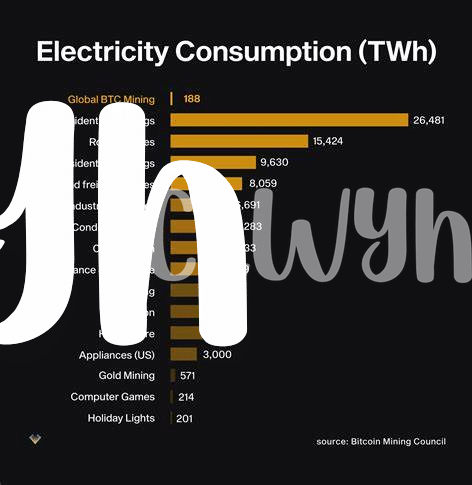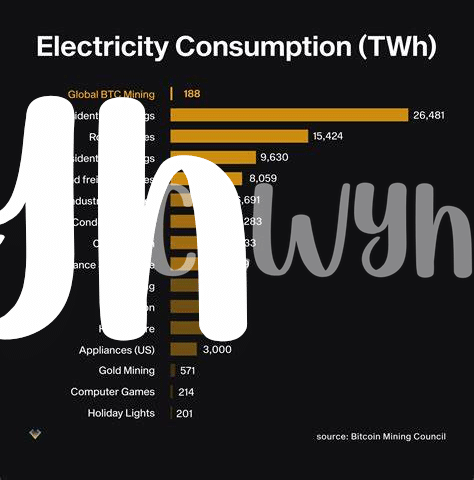🌍 Setting the Scene: Why Bitcoin Uses Electricity

Imagine a world where digital currencies are as common as the internet. In this world, Bitcoin stands tall, a pioneering force in the realm of digital money. But to keep this digital world running, it needs energy, much like a lamp needs electricity to light up a room. Every transaction, from buying your morning coffee with Bitcoins to trading them on digital exchanges, depends on computers solving complex puzzles. These aren’t just any computers; they’re super powerful machines that work around the clock, consuming a lot of electricity. It’s a bit like having a supercomputer in your home, constantly running to keep the Bitcoin network secure and functional.
| Activity | Energy Consumption (Approximate) |
|---|---|
| Traditional Banking System | 100 TWh/year |
| Bitcoin Mining | 120 TWh/year |
💡 This heavy use of energy is significant, leading many to question how sustainable Bitcoin’s electricity consumption is. Compared to traditional banking systems, the energy used for Bitcoin mining is becoming notable. As you can see in the table above, the comparison highlights the energy footprint of both sectors. This draws attention to an important question: As we move forward, how do we balance Bitcoin’s growing demand with the need for sustainable energy solutions? 🌱
💡 Comparing Bitcoin to Traditional Banking Systems
When thinking about the electricity that keeps our world running, it’s easy to picture the lights in our homes, the screens we stare into for hours, and the countless gadgets that fill our lives. But what about money itself, especially the digital kind like Bitcoin? Most folks don’t realize that just like banks with their big buildings and ATMs need power, Bitcoin, a kind of digital money, does too. Here’s the thing: sending Bitcoins from one person to another uses a lot of computer power, and therefore, a lot of electricity. Now, you might wonder how this stacks up against the traditional way of moving money around, using banks. Well, banks aren’t just about the physical branches and ATMs; they also have massive data centers processing millions of transactions, which gulp down huge amounts of power. While Bitcoin does use a surprising amount of electricity, it’s important to remember that the banking system isn’t exactly light on power consumption either. In a world that’s paying more attention to how we use our resources, understanding the energy footprint of both traditional and digital currencies is crucial. It opens up a fascinating conversation on finding that sweet spot where technology meets sustainability. For those interested in diving deeper into the potential benefits and broader applications of blockchain beyond Bitcoin, a visit to https://wikicrypto.news/beyond-bitcoin-exploring-the-variety-of-blockchain-applications can provide some intriguing insights.
🚀 the Global Footprint of Bitcoin’s Energy Use

Bitcoin, the digital gold captivating the world, leaves a hefty energy footprint, much like its tangible counterpart requires significant resources to mine. This energy consumption isn’t just a number; it translates into a considerable impact on our planet. Imagine all the electricity that goes into keeping Bitcoin running, from the computers solving complex puzzles to secure transactions and create new bitcoins, to the systems that keep this afloat 24/7. It’s a process that devours an enormous amount of power, comparable to the annual energy usage of entire countries. This comparison isn’t overblown; studies place Bitcoin’s energy consumption on par with nations such as Argentina or Sweden. The environmental implications are vast, raising concerns about the sustainability of Bitcoin and, by extension, the future of how we value digital currencies. With our planet already grappling with climate change, the urgency to reassess and adapt the energy sources fueling the Bitcoin network has never been more critical. This calls into question not just the efficiency of Bitcoin mining operations but also their reliance on non-renewable energy sources, which exacerbates the global challenge of reducing carbon emissions.
🌱 Renewable Energy: a Bright Side for Bitcoin?

As we delve deeper into the conversation about Bitcoin’s appetite for power, a glimmer of hope shines through with renewable energy’s potential to green the cryptocurrency’s operations. The global shift towards sustainable energy sources is not just about keeping our skies blue and forests green; it also offers a lifeline to energy-intensive processes like Bitcoin mining. Countries abundant in solar, wind, and hydroelectric power have become hotspots for mining activities, setting a precedent that it’s possible to harness the power of Nature to fuel our digital advancements. This transition not only aligns with global efforts to combat climate change but also paints Bitcoin in a more environmentally friendly light, making the concept of a sustainable digital currency more plausible than ever before.
In the quest for greener solutions, innovators in the crypto space are not sitting back. They’re actively exploring energy-efficient technologies that could radically reduce Bitcoin’s carbon footprint. One of the promising developments is the Lightning Network, a layer built on top of Bitcoin to facilitate faster and cheaper transactions, significantly cutting down on energy consumption. If you’re new to this, don’t worry, understanding the basics is easier than you might think. Dive into bitcoin and digital identity for beginners to get a clear picture. With these strides towards integrating renewable energy and championing innovations like the Lightning Network, the horizon looks bright for not only making Bitcoin greener but also reshaping perceptions about the sustainability of crypto at large.
🛠️ Innovations Reducing Bitcoin’s Energy Consumption
In the world of digital money, people are coming up with clever ways to make Bitcoin friendlier to our planet. Think of Bitcoin mining like a giant puzzle. Initially, solving this puzzle used a lot of electricity, similar to leaving all the lights on in a skyscraper! But now, imagine if you could solve the same puzzle while using as little energy as flipping on a lamp. That’s where new technologies step in. From more efficient hardware that sips rather than gulps electricity to smarter software that ensures every bit of power is used wisely, the quest for green Bitcoin mining is on.
Additionally, there’s something really cool happening with how Bitcoin miners are choosing to power their operations. They are looking towards the sun and the wind for answers. Yes, solar and wind power are taking center stage, offering a cleaner energy source for the intricate process of mining. This shift not only paints a greener future for Bitcoin but also encourages a broader adoption of renewable energy worldwide. It’s like hitting two birds with one stone – making both our digital and real-world environments healthier.
| Improvement Area | Description |
|---|---|
| Hardware Efficiency | Upgraded mining rigs that use less energy for the same amount of computing power. |
| Software Optimization | Software that maximizes efficiency, ensuring energy isn’t wasted during the mining process. |
| Renewable Energy Sources | Switching from traditional power sources to solar and wind energy for mining operations. |
🔍 the Future: Is Sustainable Crypto Possible?

As we journey into the horizon of digital currencies, the electric hum of Bitcoin mining rigs across the globe begs the question: can we steer this digital ship towards a greener future? With the world’s eyes on Bitcoin’s voracious appetite for energy, innovators and eco-conscious minds are in a race against the clock to rewrite the crypto narrative. The heart of Bitcoin – its bitcoin scalability solutions for beginners, holds the key. From harnessing the power of sun-kissed solar farms to tapping into the breezy whispers of wind turbines, the blockchain is on the brink of an eco-revolution. Picture a world where each digital coin is a champion of sustainability, leaving a footprint so light, it’s as if it danced on the edge of the wind. The quest for greener pastures in the realm of digital currencies is not just a dream; it’s a work in progress, painting a future where Bitcoin and sustainability walk hand in hand under the vast, open sky. 🌈💼🌿
